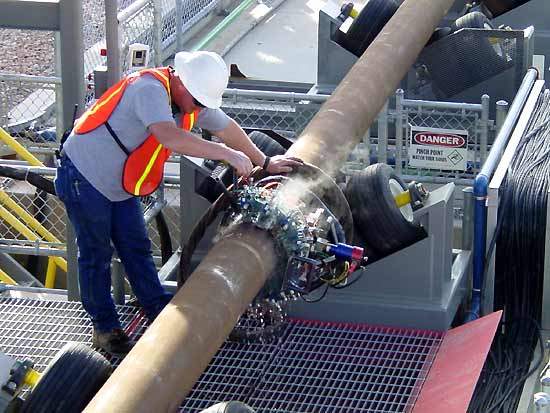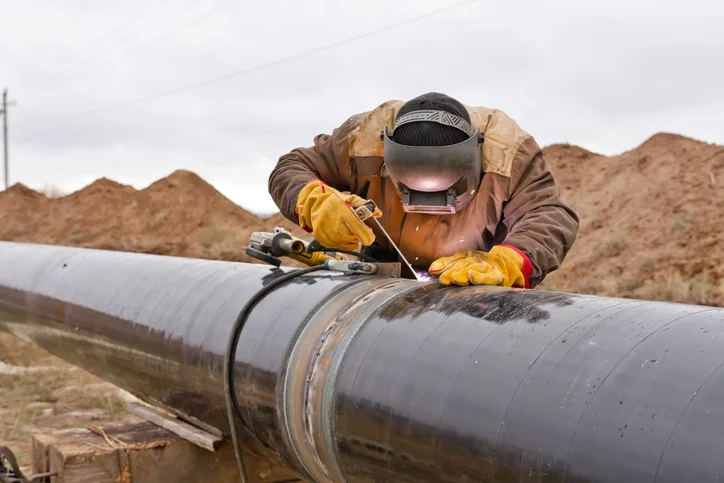Necessary Pipeline Welding Assessment Tips for Quality Control
Just how can one guarantee the high quality of these welds that attach the pipeline sections? By comprehending the necessary pipeline welding assessment pointers, professionals can avoid prospective dangers, minimize costly repairs, and promote the reliability of these crucial infrastructures.

Significance of Welding Evaluation
Welding inspection plays an essential role in making sure the structural integrity and safety of pipeline systems. By diligently checking out welds, examiners can identify any type of defects or flaws that can compromise the integrity of the pipeline. These assessments are necessary for avoiding leaks, tears, and various other possibly catastrophic failures that could result in ecological damage, financial losses, and also loss of life.
The value of welding examination can not be overemphasized, as the high quality of welds straight affects the general efficiency and long life of the pipe. Through non-destructive screening methods such as visual inspection, ultrasonic screening, radiography, and magnetic bit testing, examiners can spot imperfections that might not be noticeable to the nude eye. By determining and attending to these issues beforehand, welding examination aids to make certain that pipes meet industry requirements and regulatory needs.
Eventually, welding assessment is an essential element of top quality assurance in pipe building and construction, repair work, and maintenance (Pipeline Welding Inspection). By promoting extensive examination standards, industry experts can alleviate dangers and support the safety and security and reliability of pipe systems
Usual Welding Flaws
Among the difficulties faced in pipe welding, common defects can dramatically impact the architectural stability and efficiency of the welded joints. A few of one of the most prevalent welding issues include lack of fusion, porosity, splits, insufficient infiltration, and misalignment. Absence of fusion happens when there is poor bonding in between the weld steel and the base metal, leading to a weakened joint. Porosity, characterized by gas pockets within the weld, can reduce the toughness and make the weld at risk to rust. Cracks in the weld can propagate with time, jeopardizing the structural stability of the pipe. Incomplete infiltration occurs when the weld steel does not completely pass through the joint, causing a weak bond. Misalignment, where the weld grain is not appropriately centered, can bring about stress and anxiety focus factors and potential failing. Detecting and resolving these typical defects via thorough assessment and quality control processes are necessary for guaranteeing the reliability and safety and security of pipeline welds.
Assessment Strategies for Pipelines

In guaranteeing the structural integrity and dependability of pipe welds, the application of strenuous examination techniques is paramount. Numerous evaluation methods are employed to detect potential defects and guarantee the overall top quality of the welds. Non-destructive screening (NDT) strategies such as radiographic testing, right here ultrasonic screening, magnetic particle testing, and liquid penetrant testing are frequently utilized in pipe welding inspection. Radiographic screening involves making use of X-rays or gamma rays to find interior defects, while ultrasonic screening makes use of high-frequency acoustic waves to determine flaws. Magnetic bit testing is reliable for identifying surface-breaking issues, and fluid penetrant screening is made use of to detect surface fractures. Visual evaluation is also crucial in pipeline welding to recognize any kind of noticeable problems or suspensions. Additionally, automatic inspection methods making use of advanced innovations like robotics and drones are increasingly being used to improve the efficiency and precision of pipeline inspections. By using a combination of these examination methods, pipeline bonded high quality can be assured, and possible problems can be mitigated before they rise into larger issues.
Making Sure Quality Guarantee Specifications
To maintain rigorous top quality guarantee standards in pipeline building, careful adherence to developed sector methods and guidelines is crucial. Quality guarantee in welding procedures requires an extensive method incorporating company website numerous phases of pipe building and construction. Implementing a robust quality administration system that includes routine audits and evaluations can even more improve the overall high quality assurance requirements in pipeline welding.
Stopping Pricey Fixings
Offered the critical significance of maintaining stringent quality control requirements in pipe construction, a positive method to protecting against pricey repair work is necessary. By carrying out complete examination methods throughout the welding process, prospective concerns can be recognized and fixed beforehand, ultimately conserving both time and cash. One vital facet of stopping expensive repair work is guaranteeing that welders are correctly educated and licensed, as this dramatically reduces the likelihood of malfunctioning welds that may result in future failings. Furthermore, using innovative assessment methods such as non-destructive testing can help spot any defects or inconsistencies in the welds before they rise into significant troubles. Routine upkeep checks and tracking of environmental variables that can affect the stability of the pipe are likewise essential in avoiding costly fixings. By buying preventative steps and prioritizing top quality assurance at every phase of the pipeline welding process, firms can reduce the threat of costly repair work and ensure the lasting integrity of their facilities.
Final Thought
Finally, adherence to appropriate welding evaluation techniques is essential for ensuring the top quality and honesty of pipes. discover here By determining common welding issues and applying complete assessment processes, costly fixings can be stopped, and high quality assurance criteria can be satisfied - Pipeline Welding Inspection. It is essential for pipeline welders to focus on assessment procedures to keep the security and dependability of the facilities they are servicing
The relevance of welding assessment can not be overstated, as the quality of welds straight affects the overall efficiency and durability of the pipe. Non-destructive screening (NDT) methods such as radiographic screening, ultrasonic screening, magnetic particle testing, and fluid penetrant testing are generally used in pipeline welding inspection. Aesthetic inspection is additionally vital in pipe welding to determine any noticeable problems or suspensions. In addition, automatic inspection methods utilizing innovative technologies like drones and robotics are progressively being employed to boost the efficiency and precision of pipeline evaluations.In verdict, adherence to appropriate welding inspection strategies is necessary for ensuring the high quality and integrity of pipelines.
Comments on “Comprehensive Pipeline Welding Inspection Solutions for Professional Projects”